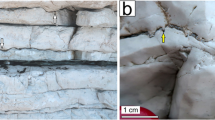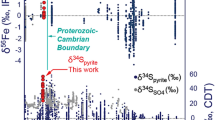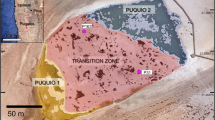Abstract
Mudstone—the most abundant sedimentary rock type1, composed primarily of clay- or silt-sized particles—contains most of the quartz found in sedimentary rocks2. These quartz grains, which are chemically and mechanically resistant and therefore preserve their characteristics well, have long been considered to be derived from the continental crust1. Here we analyse quartz silt from black shales in the eastern USA, dating back to the Late Devonian period (about 370 million years ago), using backscattered electron and cathodoluminescence imaging and measure oxygen isotopes with an ion probe. Our results indicate that up to 100% of the quartz silt in our samples does not originate from the continental crust. Instead, it appears to have precipitated early in diagenesis in algal cysts and other pore spaces3, with silica derived from the dissolution of opaline skeletons of planktonic organisms, such as radiolaria and diatoms. Transformation of early diatoms into in situ quartz silt might explain the time gap between the earliest fossil occurrences of diatoms about 120 Myr ago4 and molecular evidence for a much earlier appearance between 266 or even 500 Myr ago5,6. Moreover, if many other mudstone successions show similarly high proportions of in situ precipitated—rather than detrital—quartz silt, the sedimentary record in mudstones may have been misinterpreted in the past, with consequences for our estimates of palaeoproductivity as well as our perceptions of the dynamics and magnitude of global biogeochemical cycling of silica.
This is a preview of subscription content, access via your institution
Access options
Subscribe to this journal
Receive 51 print issues and online access
$199.00 per year
only $3.90 per issue
Buy this article
- Purchase on Springer Link
- Instant access to full article PDF
Prices may be subject to local taxes which are calculated during checkout




Similar content being viewed by others
References
Potter, P. E., Maynard, J. B. & Pryor, W. A. Sedimentology of Shale (Springer, New York, 1980).
Blatt, H. Provenance studies and mudrocks. J. Sedim. Petrol. 55, 69–75 (1985).
Schieber, J. Early diagenetic silica deposition in algal cysts and spores: A source of sand in black shales? J. Sedim. Res. 66, 175–183 (1996).
Tappan, H. The Paleobiology of Plant Protists (Freeman, San Francisco, 1980).
Kooistra, W. H. C. F. & Medlin, L. K. Evolution of the diatoms (Bacillariophyta): IV. A reconstruction of their age from small subunit rRNA coding regions and the fossil record. Mol. Phylogenet. Evol. 6, 391–407 ( 1996).
Philippe, H. et al. Comparison of molecular and paleontological data in diatoms suggests a major gap in the fossil record. J. Evol. Biol. 7, 247–265 (1994).
Seyedolali, A. et al. Provenance interpretation of quartz by scanning electron microscope-cathodoluminescence fabric analysis. Geology 25, 787– 790 (1997).
Milliken, K. L. Cathodoluminescent textures and the origin of quartz silt in Oligocene mudrocks, south Texas. J. Sedim. Res. A 64, 567– 571 (1994).
Woodrow, D. L. in The Catskill Delta (eds Woodrow, D. L. & Sevon, W. D.) 51– 63 (Special Paper 201, Geological Society of America, Boulder, Colorado, 1985).
Matter, A. & Ramseyer, K. in Provenance of Arenites (ed. Zuffa, G. G.) 191–211 (Reidel, Dordrecht, 1985).
Zinkernagel, U. Cathodoluminescence of quartz and its application to sandstone petrology. Contrib. Sedimentol. 8, (1978 ).
Schieber, J. in Shales and Mudstones Vol. 1 (eds Schieber, J., Zimmerle, W., & Sethi, P.) 187–215 (Schweizerbart, Stuttgart, 1998).
Ettensohn, F. R. et al. in Devonian of the World Vol. 2 (eds McMillan, N. J., Embry, A. F. & Glass, D. J.) 323–345 (Canadian Society of Petroleum Geologists, Calgary, 1988).
Riciputi, L. R., Paterson, B. A. & Ripperdan, R. L. Matrix effects in the analysis of light (S, C, O, H) isotope ratios by SIMS. Int. J. Mass Spectrom. Ion Process. 178, 81–112 ( 1998).
Blatt, H. Oxygen isotopes and the origin of quartz. J. Sedim. Petrol. 57, 373–377 (1987).
Blatt, H. & Totten, M. W. Detrital quartz as an indicator of distance from shore in marine mudrocks. J. Sedim. Petrol. 51, 1259–1266 (1981).
Schieber, J. Distribution and deposition of mudstone facies in the Upper Devonian Sonyea Group of New York. J. Sedim. Res. 69, 909 –925 (1999).
Carroll, A. R., Stephens, N. P., Hendrix, M. S. & Glenn, C. R. Eolian-derived siltstone in the Upper Permian Phosphoria Formation: Implications for marine upwelling. Geology 26, 1023– 1026 (1998).
Parrish, J. T. Interpreting Pre-Quaternary Climate from the Geologic Record (Columbia University Press, New York, 1998).
Wollast, R. & Mackenzie, F. T. in Silicon Geochemistry and Biogeochemistry (ed. Aston, S. R.) 39–76 (Academic, London, 1983).
Füchtbauer, H. Sedimente und Sedimentgesteine (Schweizerbart, Stuttgart, 1988).
Tyson, R. V. & Pearson, T. H. in Modern and Ancient Continental Shelf Anoxia (eds Tyson, R. V. & Pearson, T. H.) 1– 24 (Special Publication 58, Geological Society of London, 1991).
Calvert, S. E. & Pedersen, T. F. in Organic Matter: Productivity, Accumulation and Preservation in Recent and Ancient Sediments (eds Whelan, J. K. & Farrington, J. W.) 231– 263 (Columbia University Press, New York, 1992).
Kepferle, R. C. in Petroleum Geology of the Devonian and Mississippian Black Shale of Eastern North America (eds Roen, J. B. & Kepferle, R. C.), USGS Bull. 1909, F1–F23 (1993).
Round, F. E., Crawford, R. M. & Mann, D. G. The Diatoms: Biology and Morphology of the Genera (Cambridge Univ. Press, Cambridge, 1990).
Maliva, R. G., Knoll, A. H. & Siever, R. Secular change in chert distribution; a reflection of evolving biological participation in the silica cycle. Palaios 4, 519–532 ( 1989).
Ettensohn, F. R. in Shales and Mudstones Vol. 1 (eds Schieber, J., Zimmerle, W. & Sethi, P.) 109–128 (Schweizerbart, Stuttgart, 1998).
O'Brien, N. R. & Slatt, R. M. Argillaceous Rock Atlas (Springer, New York, 1990).
Hathon, C., Sibley, D. & Cambray, F. W. The Origin of the Quartz in Antrim Shale (Report FE-2346-61, US Department of Energy, 1980).
Hallam, A. Phanerozoic Sea-Level Changes (Columbia Univ. Press, New York, 1992).
Acknowledgements
This work was supported in part by the Geoscience Research Program, Office of Basic Energy Sciences, US Department of Energy with Oak Ridge National Laboratory, managed by Lockheed Martin Energy Research Corp., the National Science Foundation, and the Donors of the Petroleum Research Fund, administered by the American Chemical Society.
Author information
Authors and Affiliations
Corresponding author
Rights and permissions
About this article
Cite this article
Schieber, J., Krinsley, D. & Riciputi, L. Diagenetic origin of quartz silt in mudstones and implications for silica cycling. Nature 406, 981–985 (2000). https://doi.org/10.1038/35023143
Received:
Accepted:
Issue Date:
DOI: https://doi.org/10.1038/35023143
This article is cited by
-
Mapping amorphous SiO2 in Devonian shales and the possible link to marine productivity during incipient forest diversification
Scientific Reports (2023)
-
Origin, formation, and transformation of different forms of silica in Xuanwei Formation coal, China, and its’ emerging environmental problem
Environmental Science and Pollution Research (2023)
-
Quartz types, genesis and their geological significance within the Wufeng-Longmaxi Formation in north-western Hunan, China
Frontiers of Earth Science (2023)
-
Weathering in a world without terrestrial life recorded in the Mesoproterozoic Velkerri Formation
Nature Communications (2019)
-
Mixed biogenic and hydrothermal quartz in Permian lacustrine shale of Santanghu Basin, NW China: implications for penecontemporaneous transformation of silica minerals
International Journal of Earth Sciences (2018)
Comments
By submitting a comment you agree to abide by our Terms and Community Guidelines. If you find something abusive or that does not comply with our terms or guidelines please flag it as inappropriate.



